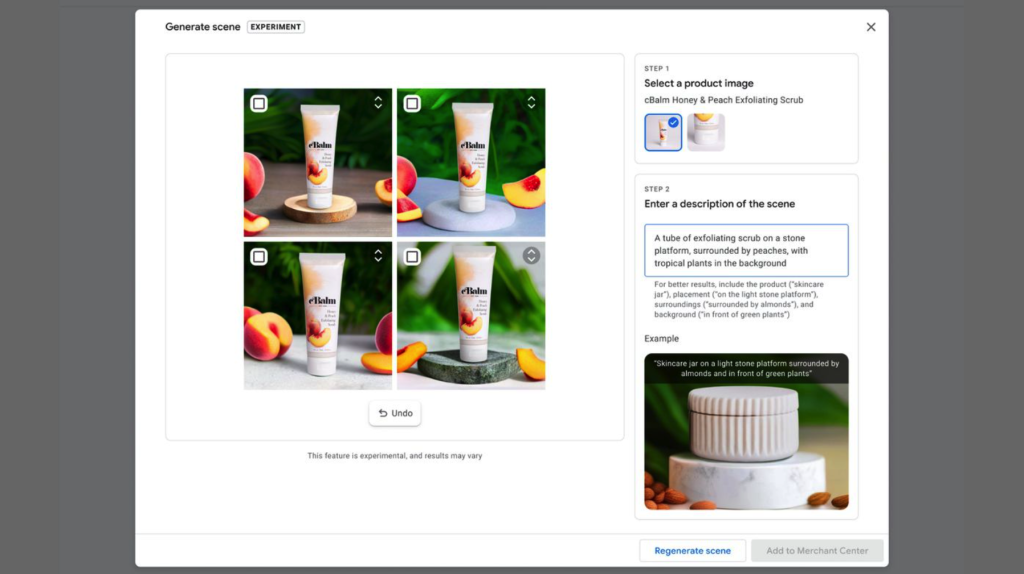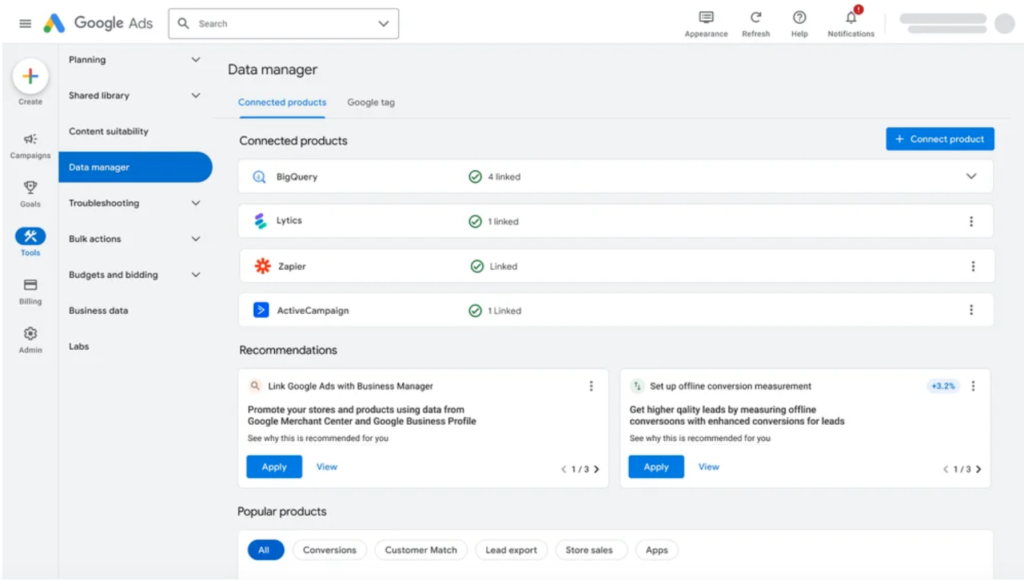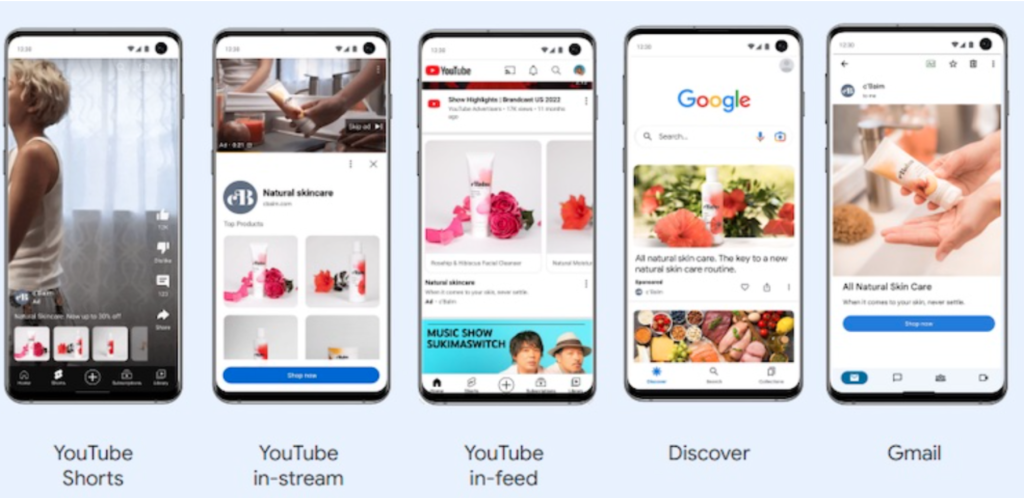At Google Marketing Live 2023, the main topic of discussion was the application of artificial intelligence (AI) in Google Ads. Google has long explored AI, as evidenced by the introduction of Performance Max, a campaign primarily based on this technology. However, the company has decided to take things further by announcing plans to introduce new AI-powered products. It was emphasized during the event that the goal of AI is to assist advertisers in their work, not replace them entirely (a concern some specialists may have).
Google Merchant Center Next
Google Merchant Center will be replaced by Google Merchant Center Next. In addition to an improved interface and simplified product data feed setup, Google is introducing Product Studio, a tool that allows you to modify the appearance of product images. You’ll have the ability to generate new product visuals, add or remove unattractive backgrounds, among other features.
This tool also allows you to create unique settings for products. You can customize their appearance, adding specific elements or themes, such as a festive holiday atmosphere or a relaxed vacation vibe. In this way, Google Merchant Center Next not only makes working with product data more intuitive but also opens up creative possibilities for shaping the product’s image.
Why Is This Important?
The new photo editing features in Google Merchant Center will allow you to highlight the qualities of your products in the Google Shopping space. With Product Studio, you can experiment with various images without needing a graphic designer, significantly speeding up the process of creating and testing new visuals. Additionally, the ability to edit images will help you emphasize seasonality and uniqueness of individual products. Another benefit is the automatic enhancement of low-quality images’ resolution, offered by Product Studio.
Generative AI in Performance Max
Google is introducing a tool in Performance Max campaigns that will further automate the ad creation process. It will enable the generation of headlines, ad copy, and even graphic materials using artificial intelligence. In addition to generating high-quality graphics from scratch, Google is also offering an AI-based image editing tool to improve existing assets, taking into account factors such as seasonality. This approach not only speeds up the campaign creation process but also allows for dynamic adjustments of graphic materials to changing market conditions.
Why Is This Important?
Generative AI undoubtedly guarantees quick results, which can greatly streamline the work of graphic designers and copywriters. These new functionalities assist in the creative process while also inspiring innovative forms of advertising communication. The key is that when using AI within Google Ads, you maintain full control over the generated assets. You can improve, edit, and experiment with different banner variations on a larger scale.
This opens up new perspectives for testing various ad versions, both visually and content-wise. Google also assures that it will never generate two identical images, eliminating the risk of two competing companies receiving exactly the same visuals.
Google Ads Data Manager
Google is set to introduce Google Ads Data Manager, a new tool that will provide access to all first-party data within the Google Ads system. The tool is designed with evolving privacy policies in mind, treating first-party data as a valuable and lasting resource.
Its key feature is a user-friendly, unified interface that simplifies the process of implementing first-party data from various sources, creating audience segments, and using that data to measure ad effectiveness. It will make conversion tracking, targeting users with relevant ads, and drawing insights from data much easier.
Google plans to fully launch Ads Data Manager in 2024, starting with core functionalities like conversion tracking and customer list activation. Additional features and integrations with external tools are expected to follow.
Why Is This Important?
Prioritizing first-party data is essential for optimizing and measuring campaign performance. Google Ads Data Manager simplifies access to this data, facilitating integration with external tools, and increasing the potential for generating additional revenue and leads. Considering the end of the third-party cookies era, leveraging and managing first-party data effectively is becoming a necessity. To maximize the potential of machine learning in Google Ads, you need to feed the system with high-quality data.
Demand Gen Campaigns
Discovery campaigns will be transformed into Demand Gen campaigns, largely driven by Google AI. Demand Gen combines the former Discovery campaign, which appeared in spaces like Gmail and Discover, and now expands to include YouTube’s network. This type of campaign is Google’s response to changing consumer behaviors and the rise of video content trends.
Demand Gen could be a great alternative to social media campaigns, grabbing audience attention with both short and long-form content. Formats like bumpers, shorts, and carousels available within this campaign are an excellent way to engage a larger audience with relevant, creative advertising messages.
Why Is This Important?
Demand Gen campaigns are a powerful tool for reaching new audiences and offer a much broader range of possibilities compared to their predecessor. While Discovery campaigns were limited to displaying images, product carousels, and product files, Demand Gen allows the use of video formats, including both standard YouTube In-Stream videos and Short-form content. This gives you a much wider canvas for creating engaging and visually appealing content that can be showcased in various locations on the YouTube platform. Additionally, Demand Gen campaigns offer a feature for targeting ads to lookalike audience segments based on your current audience lists, providing a huge opportunity to reach new potential customers.
Key Takeaways
- In 2024, Google is focusing on innovations in Google Ads, introducing new tools and features aimed at improving advertising processes, utilizing AI, and providing easier access to first-party data.
- The planned functionalities in Google Ads have the potential to significantly simplify the process of creating effective ad campaigns—with AI, you’ll gain more opportunities for creating and experimenting with new ad formats.
- Data plays a key role in the functionality of algorithms, so ensure you provide enough data, but also that it’s high-quality.
- Google Merchant Center Next: Google is introducing a new tool to replace Merchant Center, offering an improved interface and the Product Studio feature for editing product photos.
- Generative AI in Performance Max: Google is implementing generative AI in Performance Max campaigns, allowing automatic generation of headlines, ad copy, and graphic materials.
- Google Ads Data Manager: Google plans to launch the Data Manager tool, providing access to all first-party data within Google Ads, considering changing privacy policies.
- Demand Gen Campaigns: Discovery campaigns are being transformed into Demand Gen campaigns, powered by Google AI, offering new formats and the ability to reach a broader audience, including on YouTube.
Remember, relying solely on AI technology can lead to unexpected results, so it’s essential to balance automation with manual control.

Over de auteur
Karina Niksa
Senior Analytics and PPC Specialist
Bij Yetiz isze voornamelijk bezig met het uitvoeren van advertentiecampagnes op Google Ads, Ceneo en Allegro. Ze wordt gemotiveerd door de wens om haar kennis uit te breiden en haar vaardigheden te ontwikkelen met elk nieuw project, met als doel beter te worden in haar dagelijkse taken. Ze is een liefhebber van natuur en reizen, vooral naar minder bekende gebieden. Ze vindt balans in het beoefenen van yoga, breien en het bespelen van de basgitaar.





